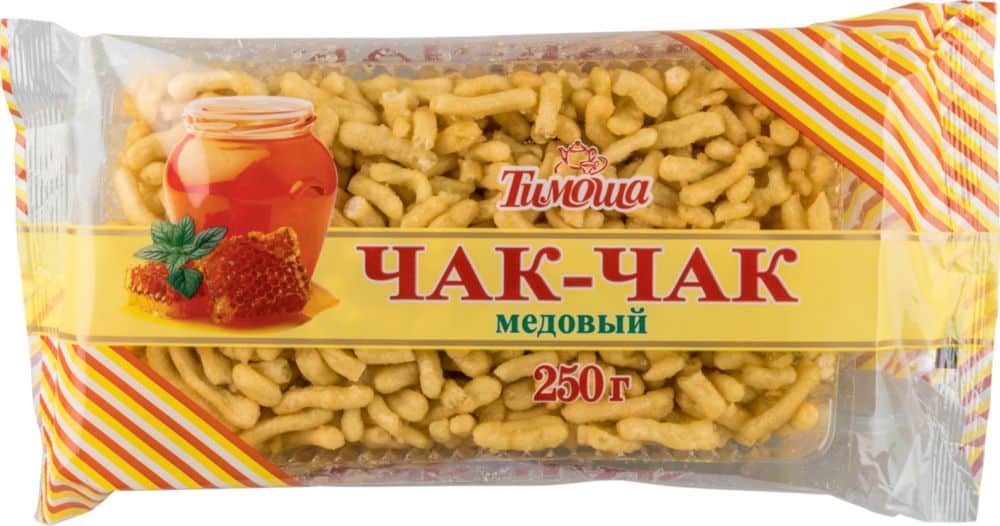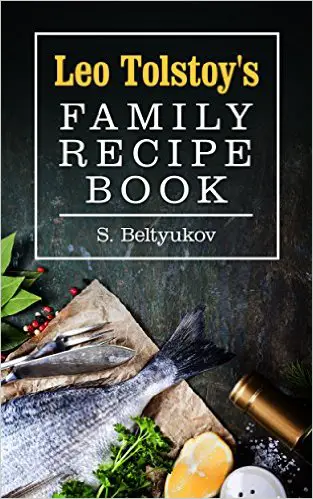Chak-chak (Чак-чак) (chak-chak) is a dessert food made from deep-fried dough drenched in a hot honey syrup and formed into a certain shape, most commonly a mound or pyramid. It is popular all over the former Soviet Union. In Russia, chak-chak is especially associated with the Tatar and Bashkortostan republics, where it is considered a national dish. However, Central Asian nationalities such as Uzbeks, Kazakhs, and Kyrgyz also lay claim to the dish… and it may have been originally taken from the Chinese. While the basic recipe is always very similar, how it is made differs from region to region.
How Chak-chak Got Its Name
(Почему он носит такое название?)
Although commonly spelled and pronounced chak-chak in Russia and Tatarstan, there are alternative, though related spellings and pronunciations. In Kazan, for example, it is often spelled “чэк-чэк” оr “шек-шек.” The name most likely came from the Tatar word “чәк-чәк,” which means “just a little bit” (it is related to the Russian “чуть-чуть,” which means the same thing).
Some say that the word was applied because the food is made up of tiny pieces. some say that, given the light, addictive taste of this very caloric food, one can imagine mothers admonishing their children to eat “чәк-чәк” as they put a batch of the dessert on the table. Some say that word actually came from the sound that a knife makes as it works through the noodles, cutting them up in preperation for their addition to the dish.
The finished “торт” is most commonly formed into a big smooth mound, but people also might form it into circles, pyramids, loafs, or, as a dish for weddings, make the final shape more complex such as a heart or even a basket (which the symbolizes a “cornucopia,” wishing the newly weds a happy and successful new life together). Modern, mass-produced chak-chak tends to be square, as that ships the most efficiently, although some homemade chak-chak is also made in blocks.

When and How to Eat Chak-chak
Как привильно есть чак-чак?
Chak-chak is a symbol of celebration and hospitality. A whole made of many pieces, it symbolizes unity. Covered in honey, a natural preservative, it also lasts for a fairly long time – up to three weeks so long as it isn’t devoured quickly.
Long ago, travelers were offered the treat upon their arrival in Tatarstan. One story says that chak-chak spread so widely around the former Russian empire because, as these travelers left, they would often ask to take more of the tasty treat with them and would share with others. Likewise, Tatars would bring chak-chak with them when traveling and offer it as gifts to people in other cities. One modern blogger reports that her mother has actually paid for taxi rides with chak-chak; thus, perhaps it’s not too far of a stretch that the Tatar people could indeed use their treat as a kind of currency in other lands that had yet to experience the magic of chak-chak.
Chak-chak is most traditionally eaten at special occasions (such as the arrival of a traveler) or for festive events (especially weddings, where it often substitutes for cakes in Tatarstan and even in Russia as a wider whole. However, chak-chak is also now a common snack food throughout Eurasia. In this sense it resembles cake in the West: a treat that can be a major part of important cultural institutions such as birthdays or weddings, but also readily available to anyone who gets the hankering for sweet goodness.
Chak-chak is most often eaten by cutting little pieces from the mound.

How to Prepare Chak-chak
(Как правильно готовить чак-чак?)
Chak-chak is an incredibly simple dish to make and requires no special ingredients that you might have to hunt for.
The ingredients in chak-chak rarely change, but the shape of the noodles (the individual pieces are actually called “лапша,” or “noodles”) and the shape of the finished version does (which, whatever shape is given, is always called a “торт” or “cake”). Sometimes the noodles are rolled into balls, sometimes formed into short pillars, and sometimes cut into short, thin strips. Its simple, soft dough is cut into small pieces that can resemble either short noodles, (such as is common in Tajikistan and Uzbekistan), or balls, (as is common among Tatars and Kazakhs).
The Tatars were traditionally a rural people and famed beekeepers, so it seems natural that even a food so important to the culture would be made of simple, available ingredients (flour, eggs, salt, milk, oil, and, of course, honey). The procedure for making chak-chak at important events like weddings also became something of a cultural institution: some of the young ladies attending would make the dough, others would cut it, the bride would fry the pieces, and the eldest in attendance would make the syrup and form the final product. This practice is still widespread at Tatar weddings which serve chak-chak.
“Свадебный чак-чак” (wedding chak-chak) is common in Kazakhstan and Tatarstan and is not unheard of for Russians as well. Wedding chak-chak is often decorated with candy, dried fruit, hazelnuts and other “украшения” (decorations) as the hot syrup cools and the dish solidifies.
Chak-chak doesn’t need any special hardware to make it. All that’s necessary is a bowl to beat the eggs, another to mix the dough, a thick pan with about a liter of oil (vegetable oil is the best choice) for frying, a pot for making the syrup, and a place to put the finished chak-chak and combine it with the syrup.
You can make one big final cake, a bunch of smaller ones, double or triple the recipe if you’re having a huge party, cut or form the finished chak-chak into any shape you want, and choose your favorite candy, nuts, and/or dried fruits to add tasty decoration.
You can now buy packages of chak-chak – including individual servings – in most Russian supermarkets for a relatively low price. However, if you won’t be in Russia sometime soon – or if you really want to taste how fantastic a fresh, homemade batch of chak-chak can be, you’ll need to follow the recipe below.
Let’s Cook!
(Давай приготовим!)
See below for a free recipe for chak-chak. See also the free videos online. If you are interested in cooking from Russia, Ukraine, Georgia, and other places in Eurasia, make sure to see our full, free Eurasian Cookbook online! You might also be interested in the following specialized cookbooks we’ve enjoyed:
 |
 |
 |
 |
| Чак-Чак по-татарски | Tatar Chak-Chak |
Ингредиенты
Для сиропа;
Приготовление
Приготовить сироп:
|
Ingredients
Syrup:
Preparation
Preparing the syrup:
|
Our Favorite Chak-chak Videos
This charming cooking program features a woman making chak-chak of the noodle variety. Notice that she wets her hands before shaping the chak-chak at the end to prevent herself from getting burned by the “очень горячий” chak-chak.
There is a popular science program in Russia called “Galileo.” In this longer, humorous, and amusing video, you’ll learn how to make (and not make!) chak-chak, as well as how it is mass produced, why various steps and proportions are needed, and more!
You Might Also Like
For those obsessed with all things pumpkin — pumpkin pie, pumpkin ice-cream, pumpkin-spice lattes — oromo (оромо) is sure to please. Oromo is a rolled, layered, steamed pastry that comes with various fillings (pumpkin being common and our favorite). It evokes everything we love about pumpkin season back home in the States. This main dish […] Central Asia’s rich tradition of carpet weaving reflects the region’s history, culture, and identity. From the ancient nomads of the Pazyryk Valley to the artisans of Kyrgyz yurts and the urban weavers of Samarkand, carpets have long served both practical and symbolic functions. Their materials, techniques, and motifs reflect centuries of interaction between nomadic and […] The Talking Phrasebook Series presents useful phrases and words in side-by-side translation and with audio files specifically geared to help students work on listening skills and pronunciation. Below, you will find several useful phrases and words. To the left is the English and to the above right is an English transliteration of the Kyrgyz translation. […] Kyrgyz cuisine reflects the country’s heritage of pastoral nomadism. Life was spent moving livestock from pasture to pasture and living in collapsible, transportable yurts. The livestock themselves were the primary, sustainable food source. Everything else was either gathered from the land or traded for. The Kyrgyz did not engage in intensive settled agriculture until forced […] There are few essential things to know about Kyrgyzstan. One of these is the country’s folkloric hero, Manas. You’ll find nearly everything in Krygyzstan is named after him: the main airport, national parks, major streets in nearly every city and town, and even karate clubs and movie theaters, not to mention the statues of him […]
Oromo, Orama, Khanum: A Turkic Pumpkin Delight

Knots of Culture: Central Asia’s Carpet Weaving Heritage

The Talking Kyrgyz Phrasebook

The Kyrgyz Food Dictionary

Manas and the Manaschi: Foundations of the Kyrgyz Soul





